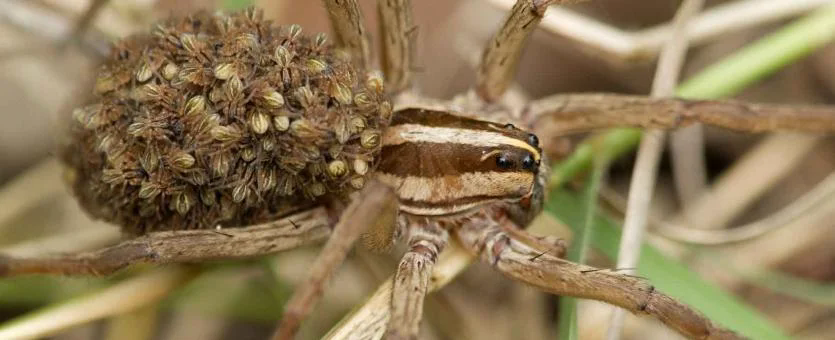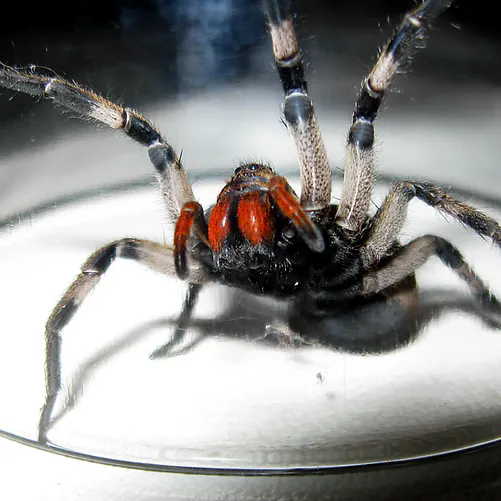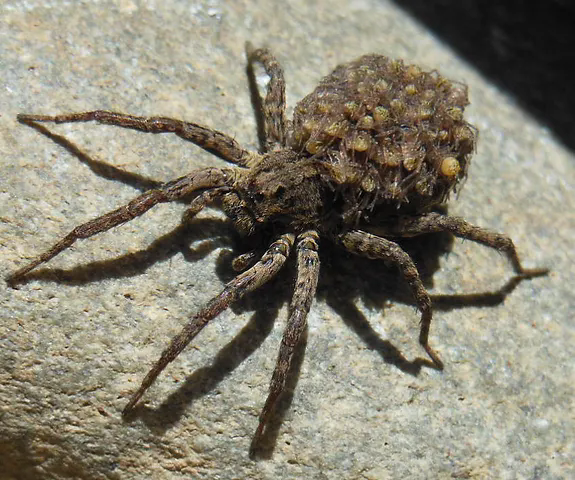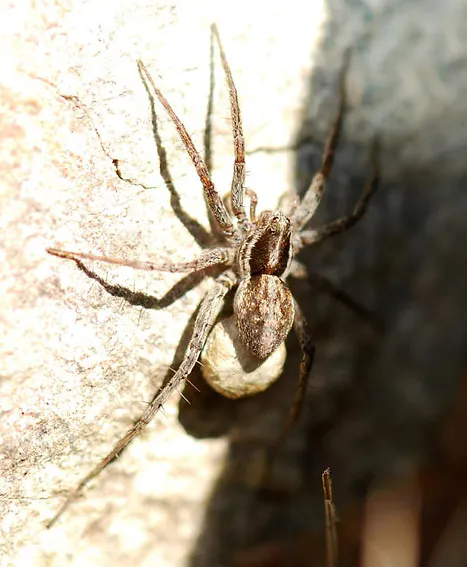

The Wolf Spider got its name because it stalks its prey like a wild dog. Its Latin name is Lyosidae, Genus Lycosa (after Lycaon, whom Jupiter turned into a wolf.) It is an open range hunting spider.
The female grows to 35mm and the male to 20mm. They are a small to medium size spider. They can be grey or brown with marking on their back which can be black, orange, grey or brown. The Wolf Spider has three rows of eyes, two at the back, two in the centre and four in the front. They are a long-legged, hairy spider.
Habitat:The Wolf Spider lives all over Australia. They live near water, open woodlands, grasslands, gardens and forests. They dig burrows 25cm deep with their jaws where they live. They like the clay and sand mix best, then they build a silk fence mixed with leaves to keep the water out. Some of the species have a lid on their burrows.
Prey:The Wolf Spiders eat crickets, locusts, other spiders, ants, grasshoppers, frogs, lizards, mice and tiny birds. The spider leaves its home at dusk, looking for food. The Wolf Spiders rely on good eyesight, speed and strength in stalking prey. The Wolf Spider can overpower a large cricket this way. The spider cannot eat meat, they can only drink the liquid out of the prey. They use a sucking motion like drinking liquid through a straw. Wolf spiders’ main enemy is man and the spider-hunting wasp which attacks and devours the wolf spider.
Breeding:The male Wolf Spider courts the female by waving his pedipalps and front legs in the air. The male spider spins a silk ball and puts sperm on it, then puts the sperm on the swollen ends of the palps.When the female is ready, the male puts the palps on the female’s abdomen. The female can then fertilise one week or one month later, whenever she chooses. The male spider does not live more than one breeding season. The female Wolf Spider looks after the eggs by dragging them behind her. When the eggs hatch, the spiderlings cling to the mother’s back with special hairs on their legs. Many of the spiderlings will fall off and die. If two female Wolf Spiders fight, the living spider will eat the other female and take her spiderlings as her own, on her back. Many will fall off and perish. She will carry them around with her own young for up to 6 months. Finally they climb grass blades, spin strands of silk and “balloon” away to new places. Spiders of most families, however, take little care of their offspring.
Venom:The Wolf Spider is not an aggressive spider. If the spider is handled, it can cause a painful bite which may cause infection and skin lesions to some people. No human has died from the bite of the Wolf Spider but a fully grown Labrador can die in a few hours after being bitten by a Wolf Spider. When bitten, the venom enters the body through the spider’s fangs. The Wolf Spiders fangs are needle-like apparatus which administer venom. They point downward from their bodies. The male and female of the species generally have the same venom toxicity, or at least no studies have been done to prove otherwise. There is no special first aid required after a bite, but see your doctor if bitten.
Wolf spiders of the genus Lycosa have been implicated as one of a group of spiders responsible for bites which cause massive tissue damage and maddening pain. This process of tissue death is known as “necrosis” and necrosis from animal venom is usually self limiting and not gangrenous. But in the case of damage from spider bites, known as “necrotising arachnidism”, the loss is extensive and irreversible, reaching through all layers of skin. The Black House spider (Badumna), along with the Wolf spider are two spiders in Australia, whose bites have been known to cause this damage. Scientists are still battling to come up with a way of arresting the necrosis apart from amputation. However, many bites are attributed to spiders that are really from other sources and in the majority of cases bites have little effect on humans.

Nearly 250 species in North America north of Mexico
FamilyLycosidae (wolf spiders) in the order Araneae (spiders)
DescriptionWolf spiders are members of the family Lycosidae. These are athletic spiders that don’t spin webs to catch their prey; instead, they run it down. They have long legs and are usually gray, brown, black, or tan with dark brown or black body markings (especially stripes).
A female wolf spider carries her egg sac in a unique way: She attaches it to her spinnerets at the bottom rear of her abdomen. Later, she carries her babies on her back.
The eye configuration is similar to that of jumping spiders: The two center eyes of the top row are enlarged. But unlike jumpers, wolf spiders have a row of four small eyes below the four larger ones. Also, wolf spiders run smoothly over the ground and often hunt at night, while jumpers hunt in plants during the day, move jerkily, and jump great distances.

Similar species: Tarantulas are much larger and heavier. Fishing spiders carry their egg sacs in their jaws, swim in and walk on water, don’t carry their babies on their backs, and don’t have the two large forward-facing eyes.
SizeLength (not including legs): from ¼ inch to 1 inch (varies by species; males are usually smaller than females).
Wolf spiders are a family of mostly large, hairy and athletic arachnids. Rather than catching their prey in webs, wolf spiders chase it down similar to the way a wolf does, although these spiders hunt alone, not in packs. There are nearly 2,400 wolf spider species across 125 genera, according to the Integrated Taxonomic Information System (ITIS). They live around the world and are found throughout the U.S. Wolf spiders are especially common in grasslands and meadows, but they also live in mountains, deserts, rainforests and wetlands — anywhere they can find insects to eat, according to the University of Michigan’s BioKids website.
WHAT DO WOLF SPIDERS LOOK LIKE?
Wolf spiders are usually brown, gray, black or tan, with dark markings — most commonly stripes, according to the Missouri Department of Conservation. Their coloring is effective camouflage, helping them catch their prey and hide from predators. Wolf spiders’ size varies, and their body lengths range from about a quarter of an inch (0.6 centimeter) to over an inch (3 cm) long, not including their legs. The Desertas wolf spider (Hogna ingens) from Deserta Grande Island in the Atlantic Ocean is one of the largest wolf spiders and has a leg span of 4.7 inches (12 cm), according to the Bristol Zoological Society in England. Female wolf spiders are typically larger than males.
Wolf spiders have a “distinctive eye arrangement, where the front or anterior row is composed of four small eyes of roughly the same size arranged in almost a straight row,” said Jo-Anne Nina Sewlal, an arachnologist at the University of the West Indies in Trinidad. (Sewlal spoke with Live Science in 2014 and died in 2020.) “The back or posterior row is arranged in a V-pattern with the apex next to the anterior row.” Wolf spiders have excellent night vision and primarily hunt in the dark. “They are also quite easily detected at night due to their eyeshine,” Sewlal said.
ARE WOLF SPIDERS DANGEROUS?
Wolf spiders can bite if threatened, but their venom doesn’t pose a serious danger to humans. According to Penn State’s College of Agricultural Sciences, wolf spiders bite humans when they are mishandled or trapped next to the skin. Bite victims may exhibit some redness or swelling, but no serious medical problems caused by a wolf spider bite have ever been reported. However, wolf spider bites can be very painful, so these critters shouldn’t be picked up by hand, the University of Kentucky’s Department of Entomology notes. Brown wolf spiders can be confused with more venomous brown recluse spiders, especially in houses. Fast-moving spiders on the ground are more likely to be wolf spiders, as brown recluse spiders are very rarely seen out in the open, according to the University of Kentucky. People can tell the spiders apart using size and banding patterns; wolf spiders are usually larger and have banding patterns on their legs, which are absent on brown recluse spiders. Anyone who has been bitten by a brown recluse spider should seek emergency medical attention, according to MedlinePlus, a service of the National Library of Medicine.
HABITAT AND FEEDING
Wolf spiders are solitary animals that typically roam alone in the night, stalking prey. They are “mostly nocturnal and often mistaken for tarantulas,” Sewlal said. These spiders spend most of their time on the ground, but they can climb trees or other objects if they need to. Their habitats include stream edges, gravel and low vegetation, according to the Missouri Department of Conservation. Wolf spiders sometimes find their way into houses, usually in basements, crawl spaces and breezeways after they enter near ground level, according to Michigan State University’s Plant & Pest Diagnostics. Wolf spiders eat mostly ground-dwelling insects, such as crickets and other spiders. Large females may take on small amphibians and reptiles, according to BioKids. Some species chase down and seize their prey, while others wait for prey to walk by and then ambush it. Wolf spiders often jump on their prey, hold it between their legs and roll over on their backs, trapping their prey with their limbs before biting it and injecting their venom.Wolf spiders use their keen eyesight, camouflage, speedy movements and high sensitivity to vibrations to help them avoid predators such as lizards, birds and hunting wasps. According to the Smithsonian, hunting wasps paralyze wolf spiders with a sting, drag them back to burrows and lay eggs in them so larvae hatching from the eggs have something to eat.
Female wolf spiders leave scent markings so males can find them to mate. When a male locates a female, they perform a courtship ritual in which the male signals to the female by waving its legs and pedipalps (short, sensory appendages near their mouths), according to the Australian Museum in Sydney. After mating, female wolf spiders lay several dozen or more eggs and wrap them in silk, creating an egg sac.
”Female wolf spiders carry their egg sacs attached to her spinnerets [at the tip of their abdomens where silk is produced],” Sewlal said. Mothers are known to exhibit aggressive behavior when carrying their egg sacs. They sometimes need to drop their egg sacs to more easily escape predators. If this happens, females will search furiously to find them again and may even pick up another wolf spider’s abandoned egg sac to care for. A 2021 study published in the journal Ethology found that Pardosa milvina, a common North American wolf spider, can recognize its own egg sacs and is less likely to pick up those of unrelated spiders when given a choice. However, the spiders in the study cared for unrelated eggs as if they were their own when they did pick them up.
Wolf spiders’ maternal behavior doesn’t stop with the egg sacs. “After hatching, the spiderlings climb on their mother’s back, and she carries them around for several days,” Sewlal said. After this, the spiderlings leave their mothers and go off alone. Male wolf spiders typically live for one year or less, while females can live for several years.
